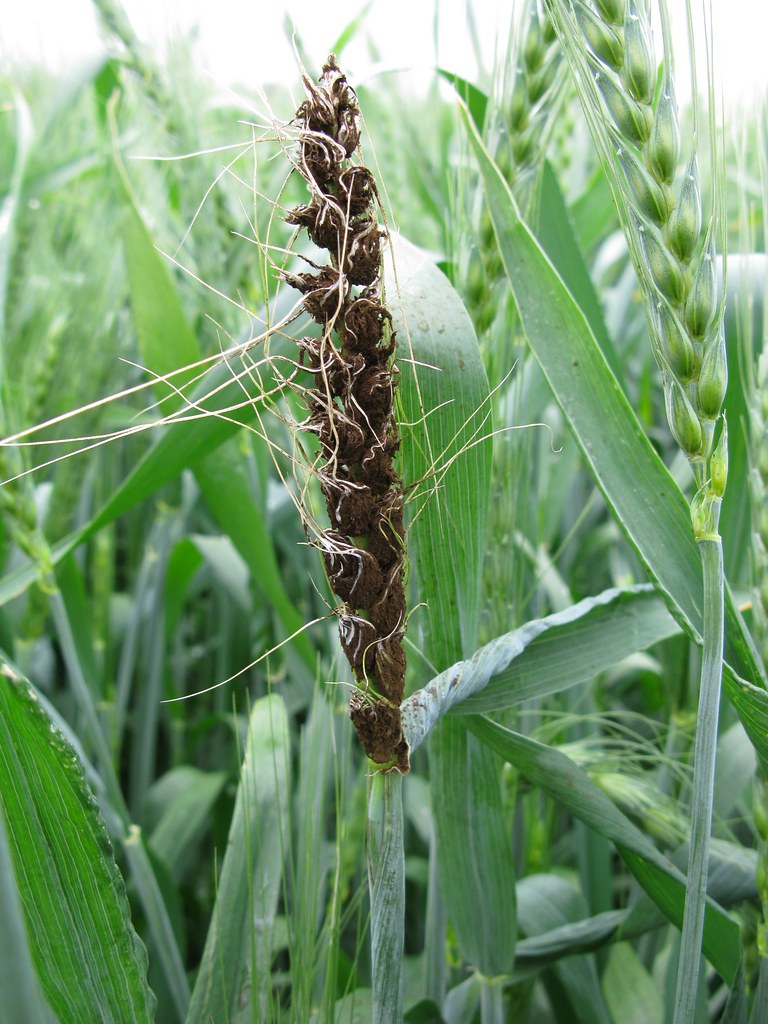
Exercise 10
SMUTS AND BUNTS
Smuts and bunts belong to order Ustilaginales of class Basidiomycetes and are important group of plant diseases. Smuts commonly attack the ovaries of the seeds and replace them with smut sori. However, there are exceptions, where smuts may attack leaves e.g. flag smut of wheat, and at the apex of stem e.g. whip smut of sugarcane. Bunts attack usually on the grains and are localized in infection. Smuts have three ways of penetration i.e. seedling type of penetration, blossom type of penetration and local type of penetration.
- Seedling type of penetration
|
Most of the smut diseases come under seedling type of penetration. The chlamydospores of such type of smuts are infested on the seed and germinate after sowing. After germination of chlamydospores, smut fungus penetrates into the tissues of seedling and becomes systemic. |
||||
|
|
||||
|
Penetration site |
Mode of Penetration |
Disease Spread |
Effective control strategy |
Examples |
|
Seedling |
Systemic |
Through seed and soil |
Seed fungicides |
Covered smut of oats and barley, loose smut of oats, head smut of corn, old bunt of wheat, flag smut of wheat, grain smut of sorghum and whip smut of sugarcane. The latter transmitted by diseased sets or through spores attached to the buds, and from infected sets fungus penetrates into the new emerging canes. |
- Blossom type of penetration
|
The fungus remains dormant within the seed until the following season and becomes activated as the seed germinates. Fungus then moves into the tissues towards the growing point of the plant, and does not show external symptoms until the blossoming. At that time i.e. blossoming, it rapidly increases in mass within the floral parts, and as the head emerges from the boot leaf, the fungus completely replaces the grain by its own chlamydospsores and destroys the floral parts. |
||||
|
|
||||
|
Penetration site |
Mode of Penetration |
Disease Spread |
Effective control strategy |
Examples |
|
Blossom |
Systemic |
Through seed |
Hot water treatment, heat treatment, seed treatment with fungicides |
Loose smut of wheat and barley |
- Local type of penetration
|
This type of penetration is localized in nature, the fungus causes infection where it lands or falls.
|
||||
|
|
||||
|
Penetration site |
Mode of Penetration |
Disease Spread |
Effective control strategy |
Examples |
|
Leaves and inflorescence |
Local |
Through soil |
Resistant varieties, crop rotation and sanitation |
New bunt of wheat, bunt of rice and common smut of maize (corn). |
Materials
Samples of above mentioned smuts and bunts.
Procedure
- First collect the samples.
- Isolate the chlamydospores or spores from the samples.
- Prepare the slides of chlamydospores, observe them under compound microscope and write down their particular characteristics.
- Prepare the slides of germinating chlamydospores and note down the characteristic differences in the morphology of basidiospore.
- Draw the diagrams of above mentioned observations and label them.
Questions
- Write down the technical names of causal organisms of all three types of smut and bunt diseases?
Ustilago triticiloose smut of wheat
Ustilago nudaloose smut of barley
U. avenaeloose smut of oats
U. kollericovered smut of oats
U. hordeicovered smut of barley
U. scitamineaWhip smut of sugarcane
Sphacelotheca sorghiGrain smut of Sorghum
S. reilianahead smut of maize
Tolyposporium ehrenbergiiLong smut of Jowar
Tolyposporium penicillariaeSmut of bajra
Tilletia cariesOld bunt of wheat
Neovossia indicanew bunt of wheat
Urocystis triticiflag smut of wheat
Ustilago maydis Common smut of maize
Tilletia barclayanaBunt of rice
- What is sorus?
A compact mass of spores or fruiting structure found especially in rusts and smuts.
- Flag smut of wheat is different from other smut fungi,justify it?
Flag smut attacks on leaves while other smuts attack on the spike and spikelets.
- What is difference between smut and bunt?
Smuts attack on spike and spikelets while bunts attack on grains only.
- Where the smut sori are produced in whip smut of sugarcane?
The smut sori are produced in the infected canes.


